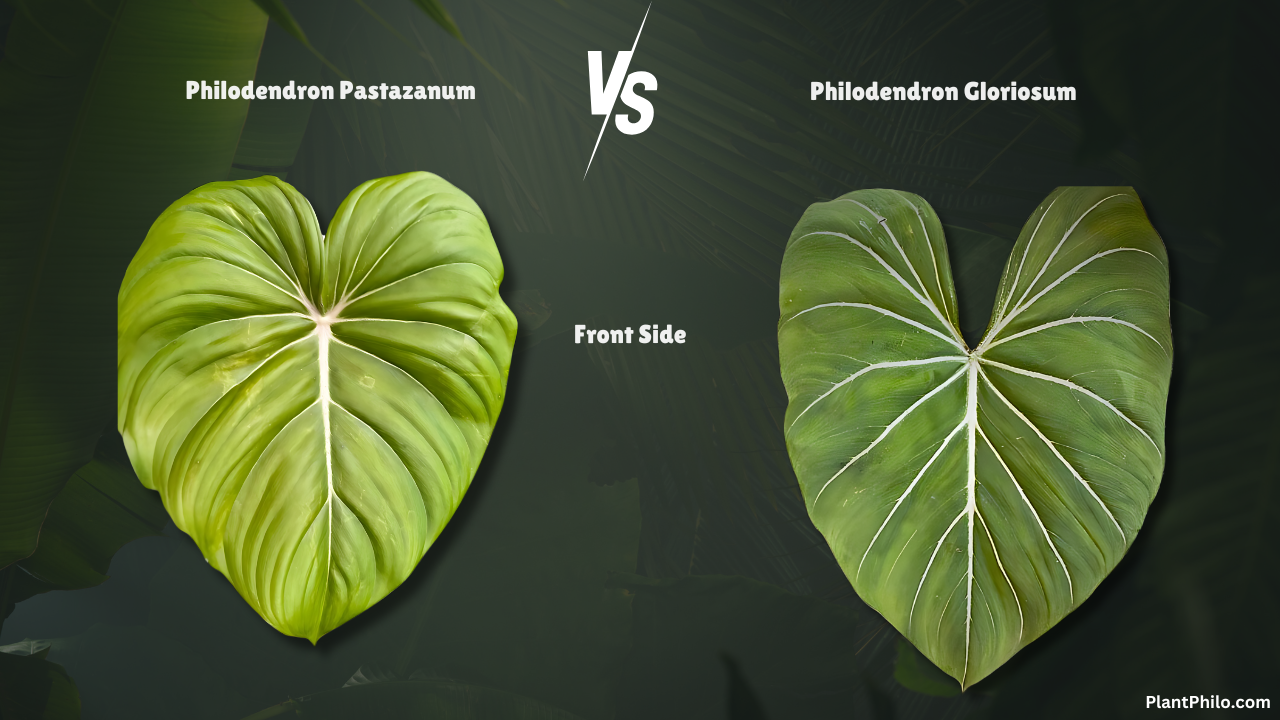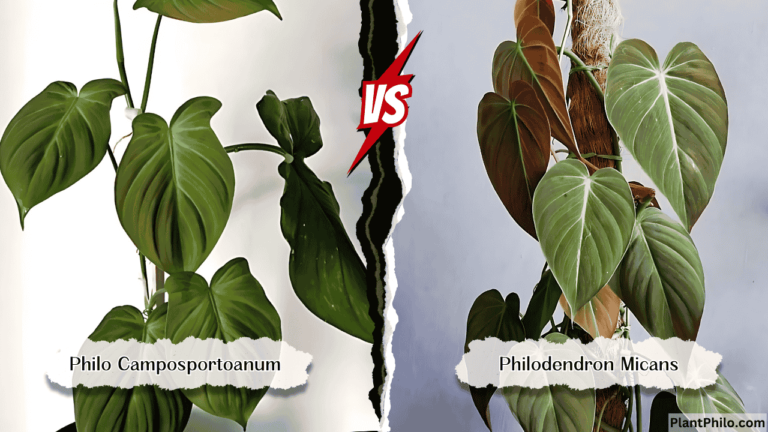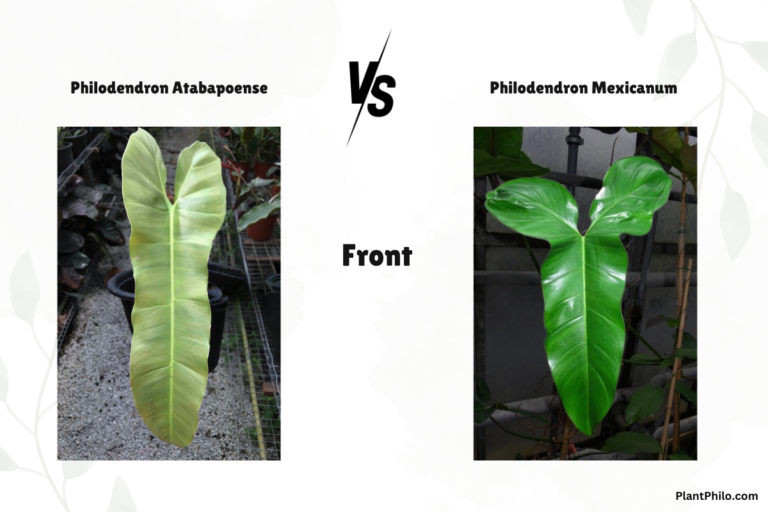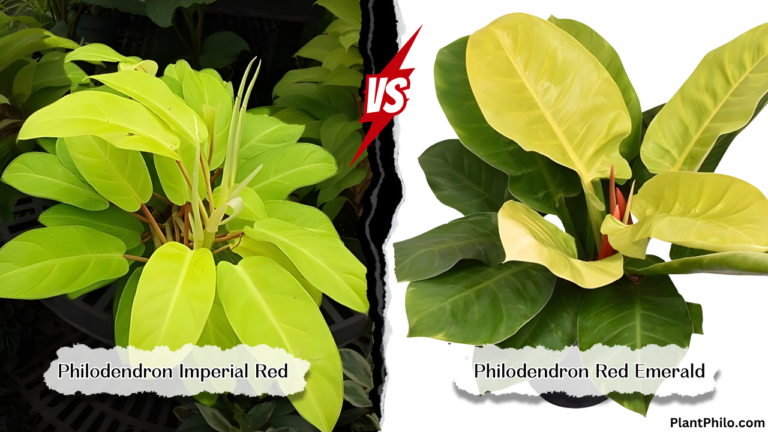Philo Pastazanum vs. Gloriosum: A Head-to-Head Comparison
Philodendron Pastazanum vs. Gloriosum – these names might sound like exotic pasta dishes, but they’re actually two of the most sought-after Philodendrons in the plant world. If you’re a plant enthusiast, you’ve probably drooled over their pictures, imagining their lush foliage gracing your home.
But let’s be honest, choosing between these two green goddesses can feel like being lost in a jungle of indecision. Fear not, fellow plant parent! We’re here to guide you through this verdant maze, shedding light on the unique characteristics and care needs of each plant.
By the end of this journey, you’ll be armed with the knowledge to make an informed choice and bring a touch of the tropics into your home without breaking a sweat (or your bank account).
Pastazanum vs. Gloriosum: Can You Tell Them Apart?
At first glance, these two Philodendrons might seem like doppelgängers, but look closer, and you’ll start to notice subtle differences that set them apart. Let’s break down their key features side-by-side:
| Feature | Philodendron Pastazanum | Philodendron Gloriosum |
| Leaf Shape | Elongated, heart-shaped with a prominent sinus and slightly ruffled edges | Large, heart-shaped with deeply lobed base and prominent veins |
| Leaf Color | Deep green with a velvety texture | Deep green with a velvety texture and sometimes reddish veins |
| Petiole | Long, reddish, and slightly hairy | Short, green, and smooth |
| Stem | Green or reddish, often with aerial roots | Thick, reddish-brown, often with aerial roots |
| New Leaf Color | Bright green or bronze | Pinkish-red or bronze |
| Growth Habit | Climbing or creeping | Creeping or terrestrial |
| Soil | Well-draining aroid mix | Well-draining aroid mix with added organic matter |
| Temperature | 65-80°F (18-27°C) day, above 55°F (13°C) night | 65-80°F (18-27°C) day, above 55°F (13°C) night |
| Humidity | High (60-80%) | High (60-80%) |
| pH Level | 5.5-6.5 | 5.5-6.5 |
| Rarity & Price | Rare, expensive | Less rare, less expensive |
| Other Notes | Requires consistent care, sensitive to overwatering | More adaptable, can tolerate some neglect |
Unraveling Their Roots: A Look at Their Origins
Understanding a plant’s natural habitat is like peeking into its past, giving us valuable insights into its care preferences.
- Philodendron Pastazanum: This rare gem hails from the tropical rainforests of Ecuador and Peru. Imagine it thriving in the humid understory, its velvety leaves catching the dappled sunlight filtering through the dense canopy. To keep it happy indoors, you’ll need to mimic these conditions with bright, indirect light, high humidity, and a well-draining potting mix.
- Philodendron Gloriosum: This beauty is native to the rainforests of Colombia and Central America. It’s a bit more adaptable than its Pastazanum cousin, tolerating slightly lower light levels and even thriving as a terrestrial plant. However, it still craves that humid jungle vibe and will reward you with stunning growth if you can provide it.
Philodendron Pastazanum vs. Gloriosum: Leaf by Leaf
Identifying these two Philodendrons is like deciphering a botanical code. The leaves hold the key!
- Shape: Pastazanum leaves are elongated hearts with a prominent sinus (the space between the lobes) and slightly ruffled edges. Gloriosum leaves are also heart-shaped but tend to be larger and rounder, with a deeply lobed base and prominent veins that create a quilted effect.
- Color: Both plants have deep green, velvety leaves, but Gloriosum sometimes surprises with reddish veins, adding a touch of flair.
- New Leaf Color: Pastazanum unfurls new leaves in shades of bright green or bronze, while Gloriosum’s new growth often emerges in a dramatic pinkish-red or bronze hue.
Stems and Petioles: The Supporting Cast
Don’t underestimate the importance of stems and petioles! They play a vital role in distinguishing these two plants.
- Pastazanum: Long, reddish petioles covered in fine hairs contrast beautifully with the deep green leaves. The stems are also often reddish and may develop aerial roots as the plant matures.
- Gloriosum: Short, green petioles provide sturdy support for the large leaves. The stems are thick and reddish-brown, often adorned with aerial roots that help the plant climb or anchor itself to the ground.
Growth Habits and Care: Nurturing Your Tropical Treasures
Both Pastazanum and Gloriosum are relatively slow growers, but they have different growth habits and require slightly different care.
- Growth Pattern: Pastazanum is a climber eager to ascend a moss pole or trellis. Gloriosum can also climb, but it’s equally happy creeping along the ground, making it a versatile choice for various spaces.
- Light: Both plants prefer bright, indirect light. Avoid direct sunlight, which can scorch their leaves.
- Water: Water when the top inch of soil is dry. Allow excess water to drain to prevent root rot.
- Soil: A well-draining aroid mix is essential for both plants. Gloriosum appreciates some added organic matter, such as coco coir or compost, to mimic its forest floor habitat.
- Humidity: Aim for high humidity (60-80%). Misting, pebble trays, or a humidifier can help create a tropical environment.
- Temperature: Both plants prefer warm temperatures between 65-80°F. Avoid cold drafts and sudden temperature changes.
- Fertilizer: Fertilize during the growing season (spring and summer) with a diluted liquid fertilizer every 4-6 weeks.
FAQs: Clearing the Jungle Mist
Which plant is more expensive, Pastazanum or Gloriosum?
Pastazanum is generally more expensive due to its rarity and slower growth rate.
Can I grow these plants in low light?
No, both plants require bright, indirect light to thrive. Low light will result in leggy growth and smaller leaves.
How often should I repot my Philodendron?
Repot every 1-2 years in the spring or summer when the plant becomes rootbound.
Why are the leaves on my Philodendron turning brown?
Brown leaves can be caused by several factors, including underwatering, overwatering, low humidity, or fertilizer burn. Check the soil moisture and adjust your care routine accordingly.
Can I propagate these plants?
Yes, both Pastazanum and Gloriosum can be propagated from stem cuttings with at least one node.
What pests should I watch out for?
Common pests include spider mites, mealybugs, and scale. Inspect your plants regularly and treat infestations promptly.
How do I train my Philodendron to climb?
Provide a moss pole or trellis for your plant to climb on. Gently tie the stems to the support as they grow.
Can I grow these plants outdoors?
Yes, but only in warm, humid climates with filtered sunlight. They are sensitive to cold and frost.
What is the best way to clean the leaves of my Philodendron?
Gently wipe the leaves with a damp cloth to remove dust and grime. Avoid using harsh chemicals or leaf shine products.
Where can I buy Philodendron Pastazanum and Gloriosum?
These plants can be found at specialty plant shops, online retailers, or through local plant groups and communities. Be prepared to pay a premium for Pastazanum, especially for mature specimens.
Choosing Your Tropical Companion
Choosing between Philodendron Pastazanum and Gloriosum is like choosing between two exquisite works of art. Both plants offer unique beauty and a touch of the exotic.
If you’re looking for a rare, statement plant with velvety leaves and dramatic new growth, Pastazanum might be your dream come true. If you prefer a more adaptable, budget-friendly option with stunning heart-shaped leaves, Gloriosum could be the perfect fit.
No matter which plant you choose, remember that both Pastazanum and Gloriosum are living treasures from the rainforest. With a little care and attention, they will thrive in your home, transforming your space into a lush, tropical oasis.




